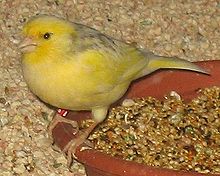
Back كناري منزلي Arabic كناري ARY كنارى منزلى ARZ Kanari BAR Канарэйка Byelorussian Kanarienvogel German Καναρίνι Greek Hejma kanario Esperanto Serinus canaria domestica Spanish قناری اهلی Persian
| Domestic canary | |
|---|---|

| |
| Domestic canary | |
Domesticated
| |
| Scientific classification | |
| Domain: | Eukaryota |
| Kingdom: | Animalia |
| Phylum: | Chordata |
| Class: | Aves |
| Order: | Passeriformes |
| Family: | Fringillidae |
| Subfamily: | Carduelinae |
| Genus: | Serinus |
| Species: | |
| Subspecies: | S. c. domestica
|
| Trinomial name | |
| Serinus canaria domestica | |
| Synonyms | |
|
Serinus canarius domesticus[3] Linnaeus 1758, I. Geoffroy Saint-Hilaire, 1861[4] | |
The domestic canary, often simply known as the canary (Serinus canaria forma domestica[5]), is a domesticated form of the wild canary, a small songbird in the finch family originating from the Macaronesian Islands (the Azores, Madeira and the Canary Islands).
Canaries were first bred in captivity in the 17th century, having been brought to Europe by Spanish sailors. Monks started breeding them and only sold the males (which sing). This kept the birds in short supply and drove the price up. Eventually, Italians obtained hens and were able to breed the birds. This made them very popular, resulting in many breeds arising, and the birds being bred all over Europe.
The same occurred in England. First the birds were only owned by the rich, but eventually the local citizens started to breed them and, again, they became very popular. Many breeds arose through selective breeding, and they are still very popular today for their voices.
From the 18th up to the 20th centuries, canaries and finches were used in the UK, Canada and the US in the coal mining industry to detect carbon monoxide. In the UK, this practice ceased in 1986.[6]
Typically, the domestic canary is kept as a popular cage and aviary bird. Given proper housing and care, a canary's lifespan ranges from 10 to 15 years.[7]
- ^ Index to Organism Names (ION) Archived February 21, 2014, at the Wayback Machine
- ^ Encyclopedia of life
- ^ ION, Index to Organism Names
- ^ The Taxonomicon
- ^ Hawley, DM; Grodio, J; Frasca, S; Kirkpatrick, L; Ley, DH (2011). "Experimental infection of domestic canaries (Serinus canaria domestica) with Mycoplasma gallisepticum: a new model system for a wildlife disease". Avian Pathol. 40 (3): 321–7. doi:10.1080/03079457.2011.571660. PMID 21711192. S2CID 205546920.
- ^ Eschener, Kat (December 30, 2016). "The Story of the Real Canary in the Coal Mine". Smithsonian. Retrieved June 11, 2018.
- ^ "Canary Care". Animal World. Retrieved February 27, 2016.